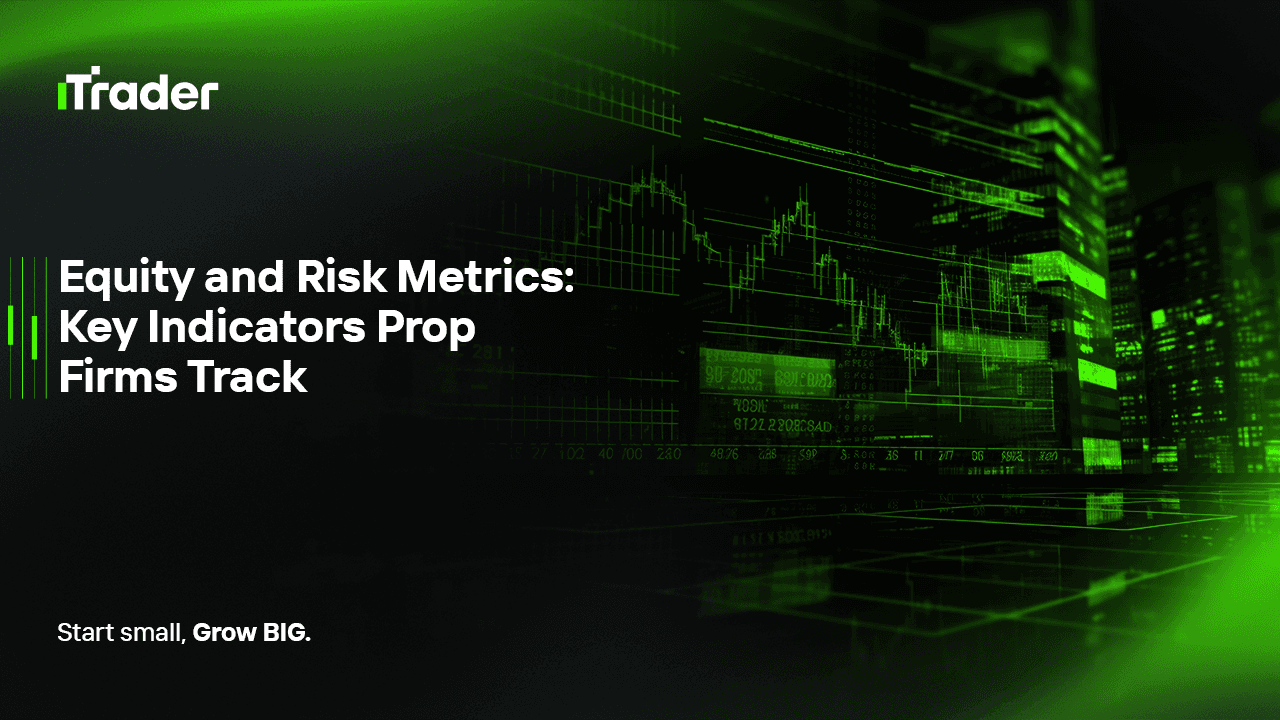2025-09-18
Every trader dreams of landing a funded account with a prop firm. The appeal is obvious: you get access to significant trading capital without risking your own money beyond the evaluation fee. But while most aspiring traders focus on how much profit they can make, prop firms are focused on something far more important: how you manage risk and equity over time.
Prop firms don’t just want traders who can hit a big profit target once. They want traders who can survive the long game. To them, it’s not about whether you can make 10% in a month — it’s about whether you can manage equity drawdowns, respect daily loss limits, and trade consistently without gambling. That’s why equity and risk metrics are at the very heart of every prop firm evaluation.

In this blog, we’ll explore the exact equity and risk metrics prop firms care about most. You’ll learn why these numbers matter, how they’re calculated, and how you can align your trading strategy with them to improve your chances of passing evaluations and keeping a funded account.
Let’s start with the basics.
Balance: This is the cash in your account excluding any open trades. If you closed all your trades right now, your balance is what you’d have.
Equity: This is your balance plus or minus any floating profit or loss from open positions.
Formula:
Equity = Balance + FloatingPnL
Example:
Equity = $10,000 + (300 – 100) = $10,200
Why prop firms care:
If your balance is $10,000 but your equity temporarily drops to $9,000 because of floating drawdown, a prop firm will count that $1,000 drop against your daily or maximum drawdown limits. In other words, equity is the true measure of risk, and it’s what firms monitor most closely.
Making money in the markets is only half the story. Without proper risk management, profits are temporary, and losses can wipe out accounts overnight. Prop firms know this, which is why their evaluations are designed to filter for traders who respect risk limits.
Risk metrics tell the firm:
These metrics don’t just matter for the evaluation stage — they’re also used once you’re funded. If you breach risk limits in a live account, your funding will be revoked, regardless of how profitable you were before.
Let’s go through the most common and important ones.
Example:
Starting balance: $100,000
Max DD limit: -$10,000
If your equity drops to $90,000 at any point, you fail the challenge.
Example:
Account: $100,000
Daily DD limit: -$5,000
If your equity drops below $95,000 on any given day — even for a second — the account is violated.
Prop firms know that one lucky trade doesn’t prove skill. That’s why they enforce rules around consistency:
Example rule: “No single trade can account for more than 30% of total profits.”
This ensures traders don’t bet big once and pray for a lucky outcome.
Example:
Passing a prop challenge isn’t just about hitting the profit target. It’s about respecting every single risk metric along the way.
Scenarios:
This is why traders who only focus on the profit target often fail challenges. Successful prop traders understand that risk metrics are the real test.
It’s worth noting that risk metrics aren’t just numbers — they’re psychological filters. Prop firms know:
By enforcing these rules, firms protect their capital and ensure only resilient, consistent traders move forward.
Equity and risk metrics form the backbone of prop firm evaluations. While many traders obsess over profit targets, the reality is that drawdowns, daily loss limits, consistency, and risk management matter far more. Prop firms aren’t searching for one-time winners — they’re searching for traders who can manage equity responsibly and perform sustainably in the long run.
If you want to succeed in prop trading, shift your mindset:
That’s the true path to not just passing evaluations, but keeping your funding and growing as a professional trader.
© 2025 iTrader Global Limited | 公司注册号 15962
iTrader Global Limited 位于科摩罗联盟安儒昂自治岛穆察姆杜 Hamchako,并受科摩罗证券委员会(Securities Commission of the Comoros)许可及监管。我们的牌照号为 L15962/ITGL。
iTrader Global Limited 以“iTrader”作为交易名称,获授权从事外汇交易业务。公司的标志、商标及网站均为 iTrader Global Limited 的专属财产。
风险提示: 差价合约(CFD)交易因杠杆作用存在高风险,可能导致资金快速亏损,并非适合所有投资者。
交易资金、差价合约及其他高杠杆产品需要具备专业知识。
研究显示,84.01% 使用杠杆的交易者会遭受亏损。请务必充分了解相关风险,并确认在交易前已做好承担资金损失的准备。
iTrader 特此声明,不会对任何个人或法人在杠杆交易中产生的风险、亏损或其他损失承担全部责任。
本网站提供的新闻及信息仅用于教育目的。用户应独立且审慎地作出金融决策。
限制条款: iTrader 不会向法律、法规或政策禁止此类活动的国家或地区居民提供本网站或相关服务。若您居住在限制使用本网站或服务的司法管辖区,您有责任确保遵守当地法律。iTrader 不保证其网站内容在所有司法管辖区均适用或合法。
iTrader Global Limited 不向以下国家/地区的公民提供服务,包括但不限于:美国、巴西、加拿大、以色列及伊朗。